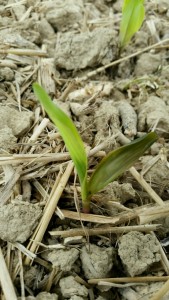Vegetables:
The hot summer-like temperatures during the week of May 4-9 caught some growers by surprise and scouts were reminding growers to keep crops watered and to open up row covers on those vegetables planted into black plastic. This was followed up by scouts reminding growers to cover up the warm season crops against the frost advisory issued for the night and early morning of May 13-14. Overall most vegetable crops are looking good at this point. The most common pests that IPM scouts are noting are some light levels of flea beetles on radishes, cabbage, vine crops and sweet corn, asparagus beetles at threshold level on asparagus and slugs with leaf feeding damage ranging from 2% to 20% on cabbage, vine crops, green snap beans and sweet corn. Some growers are using metaldehyde pellets to control slugs. (see fact sheet: to control slugs.slugs on field crops, OSU Extension) Tomatoes in high tunnels are mostly at bloom, fruit set and fruit development stages while tomatoes out in the field under row cover are beginning bloom in some fields. (See photos below) To date, onions, garlic, radish, peas, potatoes, and sweet corn crops look good. Sweet corn, depending upon the planting date is anywhere from emerging to 8-10 inches in height. Many of the warmer season crops like peppers, pumpkins, squash and cucumbers are started but have not grown well yet.
Fruit:
Apples are mostly at petal fall and peaches are also at petal fall with some at shuck split stage of development. There was a large catch of oriental fruit moth in pheromone traps set in peach orchards, resulting in a biofix date of May 7 being set. Codling moth numbers are still low in most orchards, especially those in northern Wayne County, but orchards in southern Wayne County and into Holmes County have caught more codling moths in traps and a biofix date of May 9 was set. All growers are being advised to maintain a fungicide spray program for apple scab and for brown rot in peaches. Any apple or peach orchards with a history of plum curculio damage will be applying insecticide after bloom. Small fruit development is progressing. Strawberries are at full bloom to fruit set development. Slugs are causing damage by feeding on leaves. Scouts have noted leaf feeding damage from 15-40% in some strawberry fields and have recommended use of slug baits for control. Raspberries and blackberries are at bud development. In some fields the lesser carpenter bee is really working on the pruned tips of canes. Scouts have reported as high as 45% of cane tips showing boring damage from this pest. (See photos below) Blueberries, depending upon variety are at flowering to petal drop stage of development and no pest problems noted. Grape vines are beginning growth and growers are being advised to apply an early season fungicide spray program for control of black rot, phomopsis cane blight and powdery mildew.
Agronomic Field Crops:
Most field corn is at the Ve (emergence) to V1 (first leaf by collar method) stage of growth. Some light frost damage from low temperatures the night/early morning of May 13-14 was noted on corn in low lying areas. (See photos below) In general corn looks good with uniform emergence. Slug feeding has been noted, ranging from 1% up to 20%. Scouts are beginning to see damage by black cutworm and have noted only leaf feeding at this point ranging from 1% to 8% with no cut plants yet observed. There are still soybean fields to be planted but those that were planted over the past 7-10 days have seed sprouting a few earlier fields are just starting to show some emergence. Alfalfa is growing well in most fields with heights ranging from 10 to more than 24 inches and most alfalfa at early to mid-bud. Alfalfa weevil presence and damage was light this past week. Scouts are also noting light levels of pea aphids in alfalfa. A number of farms are planning first harvest cuttings the week of May 18 depending upon the weather.
Photos by Kate Fike
Tomatoes in High Tunnels
Cane tips showing boring damage from lesser carpenter bee.
Photos by Austin Pelyak and Art Sigler






